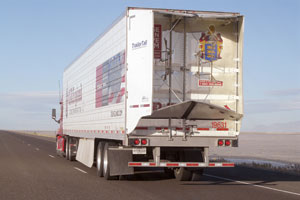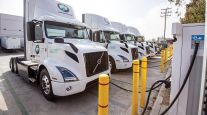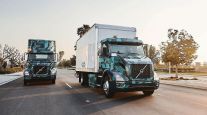Managing Editor, Features and Multimedia
Aero Installations to Shift To Factory Under GHG Rule

This story appears in the July 13 print edition of Transport Topics.
Suppliers of fuel-saving technologies for trucks and trailers said they expect their products will increasingly be installed at the factory level under the federal government’s proposed Phase 2 greenhouse-gas standards.
The proposal for Phase 2, issued June 19 by the U.S. Environmental Protection Agency and the National Highway Traffic Safety Administration, calls for progressively tighter fuel-economy and carbon-emission standards for trucks and trailers through 2027.
As original equipment manufacturers certify their trucks and trailers for the government’s increasingly stringent standards, there will be a greater need to work more closely with suppliers of aerodynamic devices, automatic tire inflation systems and other technologies designed to reduce fuel consumption, said Kenny Vieth, president of ACT Research.
“I think it becomes an assembly line process,” he said. “It’s going to become less of an aftermarket product and more of a manufacturing process.”
FlowBelow Aero, which supplies tandem fairings for tractors as well as wheel covers, currently delivers its products through collaboration with OEMs as well as through dealers and directly to fleets for retrofit, said Josh Butler, the company’s president.
Butler said less than a quarter of FlowBelow’s products are installed at OEM factories today, but he projected that figure likely would rise to more than half of the company’s business in the next two years.
“Meeting the expectations and requirements of OEMs is no easy task, but in meeting these requirements, we’ve created a better product,” he said.
SmartTruck Systems, a provider of under-tray systems and other aerodynamic products for trailers, already partners with major manufacturers of dry van and refrigerated trailers.
“I would say the working relationship will become closer, and it will be highly driven by the users of the trailers as they make decisions on products that they want to use on their trailers,” SmartTruck CEO Steve Ingham said.
For Phase 2, EPA and NHTSA would initiate their trailer program in 2018 and continue raising the bar for fuel economy and emissions reductions in 2021, 2024 and 2027.
Several suppliers said they have been increasing their manufacturing output and generally did not foresee any problems ramping up capacity to meet future demand, particularly in light of the long lead time and extended timeframe for the proposed regulation.
“The most competitive fleets in the industry will have the highest-efficiency aerodynamic packages far ahead of when the government will require them,” said Andrew Smith, founder of ATDynamics and inventor of the TrailerTail rear-drag reduction device. “I’d be very surprised if the major fleets across the country didn’t adopt this technology in the next 24 months, as opposed to waiting for the government’s timelines.”
Smith is now a consultant to Stemco, which acquired ATD in February.
He said TrailerTails are available on all major new trailer makes, either installed in the factory or across the street from the factory.
While the business was initially built on direct sales to fleets, adoption levels have reached a point where the business model is increasingly shifting to OEM installation, said Bob Montgomery, vice president of Stemco’s Innovative Tire & Mileage Solutions Group.
Some suppliers said the proposed standards represented a lower hurdle for the industry than they had anticipated, and most said they expect many fleets to adopt their products ahead of the regulation as a way to cut fuel expenses.
FlowBelow’s Butler said the government’s proposed fuel-economy improvements, particularly for trailers, were “highly conservative.”
The trailer regulation would require an efficiency gain of as much as 8% by 2027 compared with an average trailer in 2017.
“This won’t be too difficult for our industry, and major economic benefits will result,” Butler said.
SmartTruck’s Ingham said the technology exists to comply with the proposed trailer regulation. He said SmartTruck already offers component packages to boost fuel economy by up to 10%.
“If you look at our product offering today, it’s above the regulation,” Ingham said. “I think the regulation really provides a base expectation of fundamental performance.”
He also said SmartWay, a voluntary EPA program designed to help the freight transportation sector improve efficiency, has “plowed the ground” ahead of the upcoming standards.
Marc Bolduc, vice president of business development at Transtex Composite, a supplier of side skirts for trailers, predicted that Phase 2 likely would cause sales of such aerodynamic devices to accelerate gradually. He added that many fleets already have invested in them to reduce fuel expenses.
He estimated that 60% of new box trailers have skirts.
“Just as all tractors use fairings today, most box trailers will someday have a combination of boat tails, skirts and other drag-reduction devices — not because government requires it” but because of the return on investment, Bolduc said.




